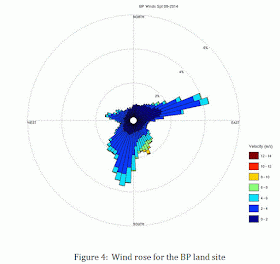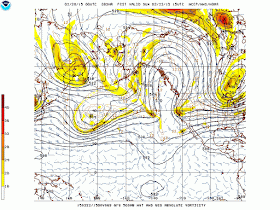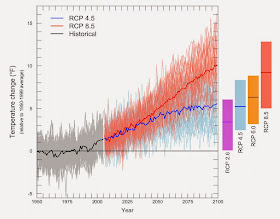In my previous blog, I talked about the anomalous and persistent high pressure/ridging that has dominated the western U.S., producing generally dry and warm conditions. And the equally persistent, and directly connected, low pressure and cold influencing the eastern U.S.
In this blog, I will spend some time examining the claims that global warming is behind it. A final blog will discuss the true origins of the western North American ridging.
Hurricane Ridge (5200 ft) in Washington Olympics is snow free, while Boston has several feet.
As I explained
in my previous blog, the proximate reason for the anomalous weather is clear: the highly amplified upper-level wave pattern with a major ridge over the West Coast and a trough over the eastern U.S. Thursday evening's (10 PM PST) 500 hPa upper-level chart (top figure) shows the story. The colors are heights (like pressures) and solid lines are sea-level pressure. Higher heights bulge up in the west and lower height over the eastern U.S. The lower picture shows temperatures in the lower atmosphere (around 5000 ft) at the same time. Warm (yellows) in the west, cold (blue/purple) in the east.
So the amplified waviness of the upper level flow (and the associated jet stream) is what is making it warm in the west. It is not due to any kind of uniform global warming over the planet. The East Coast is as anomalously cold as we are anomalously warm.
The next question is obviously: is this amplified upper level pattern and couplet of warm-west and cold-east the
result of global warming due to anthropogenic greenhouse gases or is it mainly
natural variability? I believe the facts and peer-reviewed literature suggest the latter, but you be the judge from what I will present below.
The most influential paper suggesting a global warming origin is by Jennifer Francis and Steve Vavrus:
Francis, Jennifer A.; Vavrus, Stephen J. (2012). "Evidence linking Arctic amplification to extreme weather in mid-latitudes". Geophysical Research Letters
In this paper they claim that global warming will weaken the jet stream by warming the Arctic, reducing the temperature gradients that drive the jet stream. They hypothesize that a weakened jet stream undulates more, producing a more amplified wave pattern with more cold waves in the eastern U.S. in the winter. The media has given this paper
huge play and it has been heralded by major political figures, like the President's Science Adviser, John Holdren. And many environmentalists want to believe this paper is correct.
Unfortunately, the paper is deeply flawed and most members of the research community acknowledge it. First, the Francis/Vavrus method of determining the amplitude of the waves was incorrect. Instead of measuring the daily values of wave amplitude, they mistakenly used seasonal excursions.
A paper by Elizabeth Barnes of Colorado State University did the calculation correctly and found no trends in wave amplitude.
Furthermore, there is no reason to believe the upper tropospheric jet will weaken under global warming since increased CO2 enhances warming of the upper tropical troposphere, increasing the north-south temperature gradient, thus strengthening the jet. Combined with the weakened gradient at low levels, this appears to result in jets with little change. In addition, even if Francis/Vavrus were right that the jet was weakening, theoretical research is emphatic that this would deamplify the wave pattern and not strengthen it.
You want more? There is no sign that cold waves have been increasing in the eastern U.S. as Vavrus/Francis claim; in fact, they are declining. And global climate models run under large increases of CO2 do not show the amplification that Francis/Vavrus claim.
Anyway, this Francis/Vavrus hypothesis is clearly wrong, but the media and some environmentally minded folks can't seem to let go of it.
More recently, the media and others have liberally cited
another paper by some folks at Stanford to back the global warming/West Coast ridge connection.
Written by Daniel Swain and others, this paper starts by making the case that the drought and west coast ridging is historically very unusual. This is entirely correct. So unusual and such an outlier, that great care needed to be taken in suggesting this was the result of progressive global warming of the past decades.
Then they compared climate model simulations for a pre-industrial era and the late 20th century regarding the amplitude of west coast high pressure at particular locations and found that it had increased; on this basis, they suggested that anthropogenic CO2 is increasing pressure/heights making extreme values more likely. This is, of course, true. If you warm the atmosphere, the heights of pressure surfaces (like 500 hPa) will rise. But this says NOTHING about troughs and atmospheric ridges, because they are associated with gradients of heights, not absolute values.
Lost you on this? A ridge or high pressure area is only important because heights or pressures are lower in adjacent areas. So for a ridge to become important and influence the weather, height must rise more in the ridge than elsewhere. They
did not show that and to be fair to them, they admitted this in the paper and back-pedaled in their conclusions.
So basically, their work DOES NOT LINK GLOBAL WARMING to the drought or enhanced high pressure areas along the coast.
But that did not stop the media from saying so. In fact, Stanford's PR office was pushing this angle.
Finally, there is apaper by Wang. et. al in Geophysical Research Letters (2014) that is being heavily cited in the media as proof that mankind is enhancing the western U.S. ridging:
In this paper, the authors come up with a "dipole index" that measures the amplitude of the trough/ridge pattern. Their results showed that 2013-2014 was very unusual, but if you look at their graph you will see that there is absolutely no trend, as one would expect if progressively global warming was the cause:
From GRL, Wang et al., 2014, page 3222
Then they discuss the anthropogenic influence of human greenhouse gas emissions on the dipole amplitude. Strangely, they examine how the
variance (variability) of the dipole changes in time not the critical pattern of ridging on the west and troughing in the east. They find that using analyses based on observations (the 20th century reanalysis from NOAA) that there is
little trend in variance since 1950 or since 1975 when satellite data started to become available. So this would really indicate that the real atmosphere is not changing.
But then they ran single climate simulations with and without greenhouse gases and found the variance increases with CO2. What these single simulations mean and their relevance to global warming's impact on the west coast ridging is uncertain, but this did not stop them from claiming:
"there is a traceable anthropogenic warming footprint in the enormous intensity of the anomalous ridging during winter 2013-2104."
The bottom line is that a careful reading of any of the papers claiming an anthropogenic origin of the amplified upper atmospheric waviness reveals that they all have major flaws. Or the media has hyped them beyond recognition. I don't know of any leading atmospheric scientist that is claiming such a relationship.
But that has not stopped the media from hyping the connection.
There are, in fact, a number of papers that provide a different view, that the origin is from natural variability. For example, in the same issue as Swain et al, a paper by Funk et al
looked at a large collection of climate model simulations and concluded
that global warming had no impact on the West Coast ridging:
And as I mentioned in my last blog,
a report by leading NOAA scientists have said the same thing: the West Coast ridge is probably the result of natural variability. There is no absolute certainty, of course.
Global warming is a serious issue, but we must keep it in perspective in comparison to natural variability.
In my next blog on this topic I will examine the results of recent papers that show the dominance of natural variability in producing the West Coast ridging.
KPLU Climate Talk
If you want to hear me talk about the regional implications of global climate change in some detail, please come to my UW Kane Hall talk on March 11th.Sponsored by local public radio station KPLU, tickets for this event can be secured at this web site.
The Pacific Northwest Weather Workshop
Interested in attending the big local weather workshop of the region? The Pacific Northwest Weather Workshop will be held in Seattle at the NOAA facility on February 27-28th. Everyone is invited and the majority of talks are accessible to laypeople. To attend you have to register or they won't let you in the gate. There will be a major session on the Oso landslide. There is a registration fee that covers refreshments and food, and special student pricing. If interested, check out this website.









.jpg)











.jpg)









.gif)









.gif)

.gif)
.gif)










